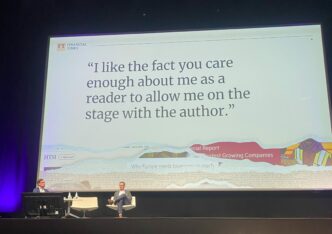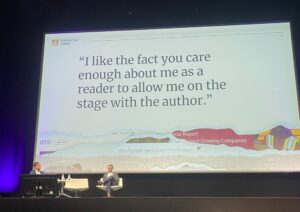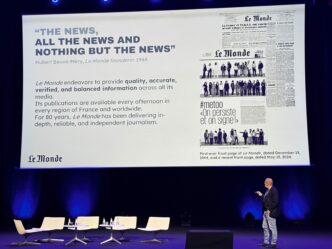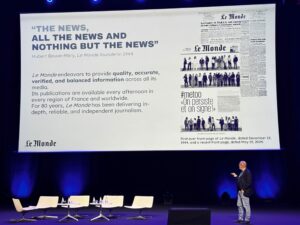

Publishers tend to put a lot more time and thinking into what content to put behind the subscription paywall and less into how to market it and best appeal to users when trying to convert them into paying subscribers.
This is partly because of journalism’s roots as a purveyor of necessary information and the “build it and they will come” mindset – and partly because it’s a marketing discipline, not a journalistic one. Which is why some journalists and editors are prone to either ignore or forget its importance.
And even though product thinking and understanding of user needs are playing an increasingly bigger part in the industry (which is why this newsletter exists), old habits still die hard.
This means that old truths and assumptions still thrive in some areas. How to market and sell your content and subscription product (which is on track to become the number one revenue generator for many publishers) is one of these areas.
Fear of Missing Out
For instance, which do you think works best? Telling people they are missing out by not buying a subscription or that they are joining in and staying in touch with what’s going on and important by buying a subscription?
Usually the “fear of missing out” is a great driver and one that always works the best, some would probably argue. But is that true?
A study based on 11 experiments conducted in collaboration with three U.S. newsrooms tries to shed some light on exactly this: “The Effectiveness of Gain and Loss Frames in News Subscription Appeals”.
In short, “gain” is when you tell people what they’ll get if they subscribe, and “loss” is when you tell them, what they are missing out on if they don’t subscribe.
It’s not only publishers who have overlooked this aspect, though; “to date, research has not examined how digital subscription appeals affect news subscription intentions,” researchers Yujin Kim, Jessica Colliera and Natalie Jomini Stroud (all from The University of Texas at Austin) write in the paper.
(Stroud is a professor at the Department of Communication Studies and the Director of the Center for Media Engagement at The University of Texas at Austin, where Colliera is a Research Associate and Kim is a doctoral student.)
Yujin Kim tells me in an email:

“While we were reviewing previous literature, there was no research like what we did, particularly as applying the theory for the field of communication and journalism (there is plenty of literature of gain/loss frames in health communication and business though) and major works in journalism tended to focus on factors that affect audience decisions to pay for news in general. We think this paper fills the gap between theory and practice.”
So, what did they find out – which works best? Well, that depends.
Facebook vs. email
The experiments were conducted using email and advertising on Facebook, and the gain and loss framed messages were accompanied by control messages with text borrowed from standard advertisements previously used by the newsrooms.
On Facebook there was little to no difference. When using email, though, gain framed messages had a bigger impact (my emphasis):
“For the studies using email appeals, however, gain messages yielded 70% more clicks to subscription pages than did loss messages […] however, the difference was only significant relative to loss messages and not relative to the control message,” the researchers write in the paper.
This means that “stay in touch” appeals work better than “don’t miss out” in a direct email. Standard neutral messages work just as well as gain framed messages, though, this study indicates.
These results have previously been published in the ‘Subscription Messages’ report from Center for Media Engagement at The University of Texas at Austin.
So, why the difference between Facebook and email? And why shouldn’t you necessarily play on the “fear of missing out” when trying to sell your subscription product?
Prospect theory
The answers may lie in prospect theory, which was applied by the researchers in order to test the effect of the various messages.
The theory was developed by Daniel Kahneman and Amos Tversky in 1979 and was cited in the decision when Kahneman was awarded the Nobel Prize in Economics in 2002.
Prospect theory describes how we tend to make decision based on the level of risk and certainty involved. Whether gain or loss is more effective varies by topic, but generally the theory proposes that gain framed messages are better when there is little risk that an action will fail to produce the desired outcome.
In the paper, the reseachers give us an example:
“As O’Keefe and Jensen (2007) explain, dental hygiene is just such a case. There is little risk, they propose, that the advocated behavior (e.g. flossing) will not produce the outcome of healthy teeth and gums. The alternative – not flossing – is riskier. Gum disease is possible, but not guaranteed, if one does not floss. Under these circumstances, gain frames perform better.”
This means, in relation to news and publishers, that if the user feels pretty confident that what they are trying to achieve (by buying a subscription) comes with little risk, then gain framed messages will work better.
As this is the case in the study, it might give us an interesting glimpse of why people are paying for subscription products from publishers (my emphasis):
“Prospect theory suggests that variation in which frame performs better is a product of the anticipated outcome of enacting a behaviour and the certainty with which the anticipated outcome will occur […] In more certain situations, gain frames perform better, whereas in riskier situations, loss frames may be the better choice.
In applying the theory to the news subscription context, we must understand what outcomes people anticipate from subscribing and whether they believe that these outcomes are likely.“
That makes sense. So how do you find out what people are trying to achieve by subscribing? This requires qualitative analysis, meaning that tools like Google Analytics won’t help you.
Jobs To Be Done
Understanding what outcomes people anticipate from subscribing and what they are hoping to achieve is usually addressed by using a framework such as Jobs To Be Done.
When using the framework you are trying to find and understand the user’s “underlying need” and the context in which the user is trying to get his or her jobs done.
A classic example in Jobs To Be Done is reading on the train. Today, many of us read on our phones, while 30 years ago we probably read books and newspapers instead. This is has to do with some of the underlying Jobs To Be Done: Passing the time.
Some might pass the time by listening instead of reading. They can listen to music (on the phone, perhaps Spotify, vs. walkman or discman earlier) or a podcast. And this is one of the core reasons why podcasts are popular with commuters; they address a Job To Be Done.
The framework focuses less on target audiences and demographics and more on the actual jobs and needs people are trying to find solutions to. In an MIT Sloan Management Review article from 2007, titled ‘Finding the Right Job For Your Product’, Clayton M. Christensen and others write:
Customers’ purchase decisions don’t necessarily conform to those of the ‘average’ customer in their demographic; nor do they confine the search for solutions within a product category. Rather, customers just find themselves needing to get things done. When customers find that they need to get a job done, they ‘hire’ products or services to do the job. This means that marketers need to understand the jobs that arise in customers’ lives for which their products might be hired.”
👆 This is what the University of Texas at Austin researchers are addressing, and the combination of Prospect Theory and the Jobs To Be Done framework is a very powerful hybrid when analyzing and understanding user behavior and goals.
Forget key and target demographics and all the pretty slides for a moment and focus on what people are trying to get done – and why they might hire your product as a solution.
There are many ways to work with Jobs To Be Done. One method is to use the framework in tandem with the Value Proposition Canvas by Strategyzer (a model built on the Business Model Canvas), which includes “Customer Jobs” when trying to design a value proposition based on knowledge and insight about the users.
As the paper from The University of Texas at Austin hints, a great, well-thought subscription product should be based on understanding of these factors and drivers.
No matter how you choose to work with the framework, finding people’s Jobs To Be Done requires conversations, interviews and observations. Get out there and talk to the people you are trying to sell your subscription product to.
Relative certainty
That said, prospect theory can give you a sense of why people subscribe to your product. Using this, you can build assumptions and hypotheses on why people buy your product, which can be tested in both qualitative and quantitative studies.
Considering the results of the experiments, the researchers write (again, my emphasis):
Subscription decisions seem to represent the relatively certain and goal-oriented situations where gain frames outperform loss frames, as prospect theory suggests. […]
Not only does this research offer guidance on what appeals to use, it sheds light into why people are motivated to subscribe to news: the superior performance of gain frames suggests that subscription decisions are motivated by feeling relatively certain about gaining beneficial information from doing so.”
This is very interesting – and great news for publishers and the news industry in general. According to this study, people see little risk when trying to achieve their goals by subscribing to news – as they feel pretty confident that they will attain those goals with a subscription.
At this point the questions are plenty:
- What are they trying to achieve? Why?
- Do they indeed feel certain? If yes, why? If no, why not?
- How are they currently solving this problem? (Always a great question to ask)
…and so on.
(If anything, it’s a reminder that we all need to understand behavioural economics and the theories involved. Even if you don’t work in the news or publishing industry, you could probably increase your chances of success by applying prospect theory.)
A Word of Caution
They are, however, some factors which should be taken into account before applying gain framed messages to everyone everywhere.
The 11 experiments were conducted with three U.S. newsrooms. Out of those, just three experiments were done using direct mail. The remaining eight were done as sponsored posts on Facebook.
This means – as is usually the case – that more testing is needed. Let this be a call to all newsrooms and marketers out there: Test gain and loss framed messages compared with control messages.
Even if you perhaps choose not to learn from the results in this study, at least choose to learn from the method. That is also Yujin Kim’s suggestion to publishers and others.
“Some are already doing A/B testing on language appeals but my suggestion is that doing rigorous experiments (even though it’s on a small scale) with different messages/images or in a different medium may help them understand about their audience better,” she explains.
Conversion tests needed
And remember: The tests should involve more than just wording in emails and on other channels. As the researchers and newsrooms discovered, few actual subscriptions resulted from the experiments which focused on click through rate as its success parameter.
This was one of their biggest surprises in the study, Yujin Kim explains to me. Therefore she suggest that publishers think about how to use each channel most effectively.
“We think using different approaches is desirable depending on the goal of the newsroom’s campaign. For example, when it comes to new audience exposure, using images on Facebook can be effective,” she explains with a reference to a paper she has previously co-authored [see link at the bottom of this article].
“If they have already built some engagement with their audience (e.g., previous subscribers) focusing on benefits from subscribing to journalism is more convincing in emails.”
This rate of conversion need not be due to anything in the experiments, as the actual conversion from user to paying subscriber happens not in an email but on a web page.
In the paper the researchers write:
“There are many possibilities for this pattern. For instance, it is possible that the link included in the messages took people to a web page that was poorly designed, so that even those most interested in subscribing were deterred. It is also conceivable that none of the messages used in this study were particularly appealing. And another, more troubling, explanation could be that advertising for subscriptions via email and Facebook is not a promising strategy.”
The lack of uptick in conversions underlines that if you decide to test framed messages in your communication, you need to make sure to test the landing pages as well.
There are many factors to take into account, both in terms of messaging, wording and design and structure of the page where the actual purchase and checkout is taking place. And the user’s Jobs To Be Done, of course.
With that many variables in the equation, publishers and others should consider rigorous testing and learning through assumptions and validations.
What’s next?
The researchers propose some interesting questions to look at, though they aren’t currently looking into them. The most interesting one is perhaps looking at gains and losses in a wider, societal context – and not just a personal one:
“Recent research from the Knight Foundation suggests that statements about societal losses may increase subscription intentions. In their research, participants who were made aware of the financial crisis facing local news were more likely to donate to local news.”
Let’s hope that someone will follow up on this.
The researchers also suggest looking more into the difference between email and Facebook.
“For example, gain-framed messages may be more effective on email than on Facebook because Facebook yields a more negative mood. Studies have revealed a negative association between Facebook usage and users’ mood […] Although email can also produce negative moods […], other studies suggest that email can improve relationships and help people stay in touch.”
There is no doubt that we are just getting started looking into these aspects of news and the publishing industry. And with prospect theory and the Jobs To Be Done framework, success becomes more likely.












